This was a brilliantly theatrical and superbly sung recreation of an opera reflecting the work’s premiere by an all-male cast.
Max Emanuel Cencic’s Bayreuth Baroque Opera Festival takes place in and around the restored 18th– century theatre in Bayreuth, originally built by Wilhelmine, Margravine of Bayreuth and sister to Frederick the Great. A striking and handsome building, one of the biggest theatres in German at the time, the festival enables it to be used for the staging of 18th-century opera.
This year the focus was on Leonardo Vinci’s Alessandro nell’Indie written for Rome in 1730 and though it was popular it was probably never performed after 1740. The opera was the first setting of Metastasio’s early (and very popular) libretto, which Handel would transform into Poro. As the premiere of Vinci’s Alessandro nell’Indie was in Rome, the female roles were all taken by castrati, something that happened in Continental Europe but never in England. This production at Bayreuth reflected this with both female characters being played by countertenors and this ethos extended to the dance troupe where four of the men performed in (very convincing) drag.
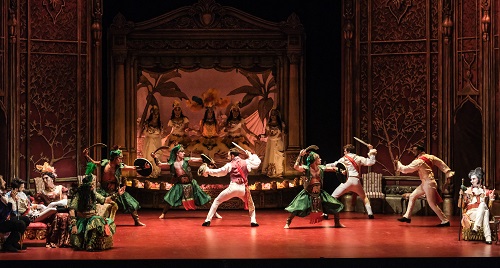
Metastasio’s libretto has its wittier elements, and the festival’s programme book suggests that having the women played by men might have brought an element to comedy to the production. Certainly, this was brought out in Cencic’s production which was far wittier and more entertaining than opera seria usually is. Also of note is that Metastasio’s use of India (a fantasy ‘other-land’ rather than a realistic depiction) enabled him to examine gender roles in a way that would not normally be considered seemly. The hero, Poro, is less heroic and more emotional, whilst the heroine Cleofide is far more rational and less emotional, a reversal of the norm. The whole opera is interested in gender roles, something made more piquant by the casting, and Metastasio’s use of comedy and of a fantasy Indian setting probably enabled him to get the opera past the rather severe Papal censors (after all this is an opera with a remarkable number of threatened suicides).
Before a note of the overture, two fops (actors Nate Harter, Connor Powles) appeared, vastly over-dressed and caricatured. The two introduced the opera (in English) and throughout they not only acted as supers but provided descriptions of the intended stage pictures, all the time in silly-ass accents.
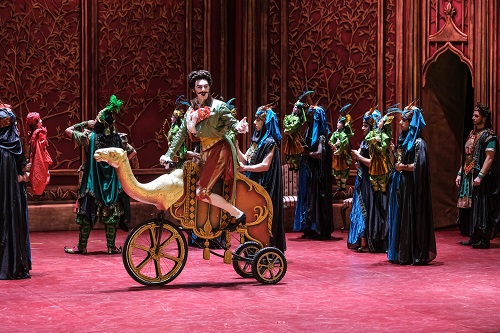
During the overture, the curtain rose on a Regency gothic room, all red and gold, very much of the style Prinny might have recognised. We were introduced to the leading characters, who sat on sofas. Poro (Franco Fagioli), Cleofide (Bruno de Sà) and Gandarte (Stefan Sbonnik) in Indian costume, with Alessandro (Maayan Licht) and Timagene (Nicholas Tamagna) in Regency dress, making Alessandro a sort of Clive of India figure – or perhaps we should see him as Prinny himself, acting out the fantasy (after all the real Prince Regent did have fantasies about defeating Napoleon). Certainly, Licht as Alessandro was very camp, deliberately so I think, and throughout the production Cencic seemed to be gently sending up Alessandro’s reputation (in the opera) as a lover of women.
A feature of the production was the sheer visual extravagance, which evoke the sort of richness that contemporary audiences would have expected. Not only did it appear to be taking place in the Brighton Pavilion, but the costumes were pure Bollywood with the Indian characters wearing outfits that seemed to be based on Mogul miniatures.
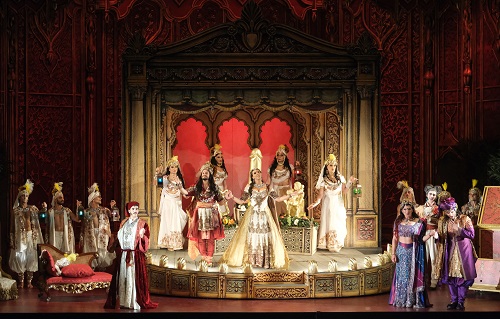
During the overture, these characters watched the battle between Poro and Alessandro’s forces being enacted by dancers (half in Regency garb, half in Indian). Then female dancers appeared on a small stage within a stage; they were played by men and another element was added to the production, that of comedy. The dancers and choreographer, Sumon Rudra, seemed to draw inspiration from Les Ballets Trocadero de Montecarlo (colloquially known as the Trocs), the remarkable American all-male dance troupe that performs ballet classics with a mixture of technical skill, comedy and great love. These three elements characterised the production. Nothing was sent up, as such, it was all done from love, but when Metastasio’s text got a bit over-heated, then the cast mined this for comedy in a way that drew you in.
Despite cuts and admirably swift delivery of the recitative, Alessandro nell’Indie is still a long opera. Act One lasted 90 minutes with the other two lasting an hour each. Cencic’s mix of gentle comedy and serious music-making helped make the piece flow. We never laughed at the characters, the production did not make that fatal mistake; we cared and when things took a darker turn in Act Two, the production followed without jarring.
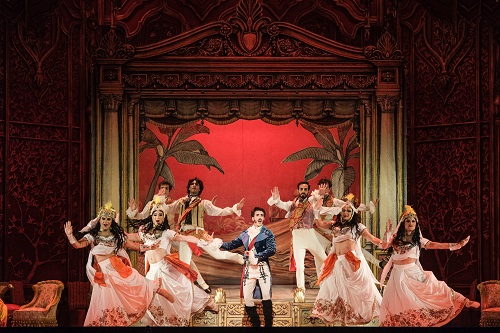
Vinci’s music is lovely, by turns dazzling and very affecting. You can clearly understand why the opera was popular. His music, however, does not mine the depths of despair in the way that Handel can, but Vinci provides space for singers to both emote and to show off. Whilst there were slow, poignant numbers, many were up-tempo with a strong dance element in the accompaniment. Cencic leveraged this by having dancers perform during the arias, a lot, thus creating a series of dazzling production numbers.
Choreographer Sumon Rudra and assistant choreographer Anna Dimitratou work in contemporary dance and Bollywood styles, and this showed in their witty, lively choreography. I will be quite frank, I normally would run a mile from opera seria enlivened by dancing, but somehow this was so engaging and witty that you could not but help smile. The singers all got drawn into the movement too and Jake Arditti as Erissena seemed particularly to end up in big production numbers.
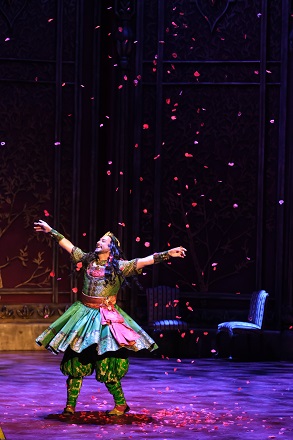
For all the title role being Alessandro, the leading man is his enemy Poro (Franco Fagioli), a character much prone to doubt and jealousy. Fagioli has a facility for dazzling, fast passagework and interpolated high notes, but he could be moving too. A quieter aria in Act One, with solo violin from Martyna Pastuszka who joined him on stage, was simply stunning. And there were other moments when he tugged the heartstrings as well has making us go ‘wow’ with his bravura. Poro, with his tendency to obsessive jealousy and reliance on threatening to commit suicide, is not the most sympathetic of characters yet Fagioli managed to make him engaging and personable.
As his lover Cleofide, who uses her wiles to tempt Alessandro (Licht) and make Poro (Fagioli) jealous, Bruno de Sà was simply superb. His voice sits very high, and he was able to produce arias of simple affecting beauty. There was bravura too, but it was in the ‘pathetic’ that Cleofide’s character was mainly expressed and Bruno de Sà did this wonderfully. Initially he rather over flutters his eyelids and indulged in too much (very funny) drag acting, but as Cleofide’s problems piled up, his character took on a sense of serious poise.
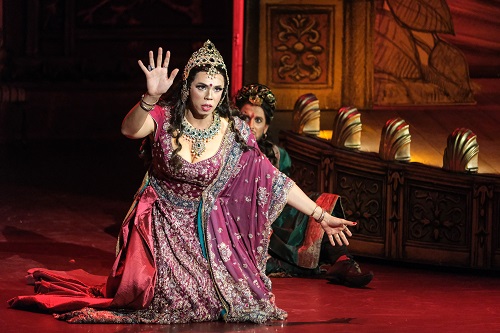
At the end of Act One, the two lovers Poro and Cleofide are rowing and in an imaginative duet each throws the other’s earlier vow at them. Franco Fagioli and Bruno de Sà really went at it and each in their cadenza took the music into demented 19th-century realms with quotations from La traviata and Rigoletto, but then it did end with that good old drag comedy standard, wig pulling!
Poro’s sister, Erissena, was played by Jake Arditti as a very feisty character. Betrothed to Gandarte (Stefan Sbonnik), she was dazzled by Alessandro (Licht) and spent the opera rather buffeted by fate and demanding she be allowed both to love Gandarte and have fun with the Greeks too, all the time reacting with vividness and spunk. Arditti was a complete delight, revealing a fine luscious counter-tenor voice, deft dancing skills and a trim belly which was put to good use in one dance!
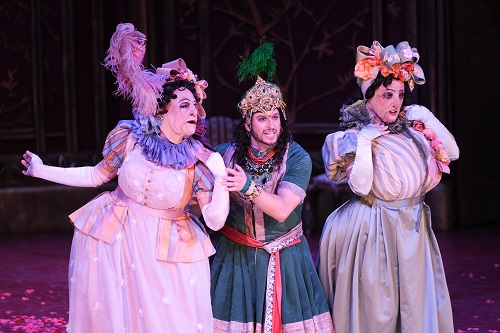
Maayan Licht as Alessandro showed a neat, light, high-lying counter-tenor voice – p erhaps a bit too light in terms of balance, but beautifully sweet-toned. He made a charmingly fey Alessandro and perfected the art of doing nothing on stage with compelling ease.
One of the elements to the casting was not just the challenge of finding countertenors able to take the various soprano and alto roles, but to provide variety in the voice types. We did indeed have this. Fagioli’s tone is idiosyncratic and distinctive, and he put this to great use ensuring that Poro’s timbre was individual. All the other singers similarly created their own sound-world, so the ear had variety in colour, timbre and style.
The two minor characters were both well taken. Nicholas Tamagna was Alessandro’s general, Timagene who secretly hates Alessandro. Timagene was played as a Lord Melbourne like statesman. Unfortunately, he was portrayed as both old and with a hump, which seemed somewhat de trop in this modern age – but Tamagna impressed with his strong characterisation.
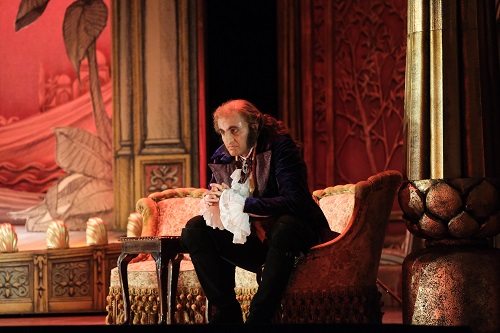
Tenor Stefan Sbonnik as Gandarte was the only lower voice. He had plenty to do and created a very engaging character. But he also brought real depth to the role, particularly with his aria at the end of Act Two when both Gandarte and Erissena (Arditti) think that Poro is dead and Erissena refuses to leave with Gandarte. He says life without her is unsupportable and Sbonnik gave us an aria of stunningly simply beauty.
The dancers were tireless, sexy, engaging, athletic and witty; they formed the backdrop to the drama with Sumon Rudra’s inventive choreography.
In the pit, which is rather more of a floor-level compound in this theatre, (oh!) Orkiestra (from South-West Poland) was in fine form. Led from the violin by Martyna Pastuszka, they made Vinci’s music expressively lyrical and positively toe-tapping. Speeds were fleet; not only did the recitative bat along impressively (so much so that the surtitles, in German and English, could not always keep up), but speeds in the arias were similarly fleet. But Franco Fagioli set the pace with vividly fast passage-work and all the other singers followed.
The whole production, with its dancing, jokes, visual splendour and serious musicality was an imaginative delight and the five hours in the theatre sped by in a way rare in opera seria. Max Emanuel Cencic’s approach would not work for every opera, but here we had brilliance, sexiness, bags of imagination, comedy, false cleavages, much batting of mascaraed eyelashes, terrific singing and a superb sense of style.
Robert Hugill
Leonardo Vinci: Alessandro nell’Indie
Franco Fagioli – Poro, Bruno de Sà – Cleofide, Jake Arditti – Erissena, Maayan Licht – Alessandro, Stefan Sbonnik – Gandarte, Nicholas Tamagna – Timagene, Actors – Nate Harter, Connor Powles,
Dancers – Aggelos Antonakos, Vasilis Arvanitakis, Rafail Boumpoucheropoulos, Konstantinos Katsoudas, Alexsandros Laskaratos, Evangelos Lyopirakis, Ioannis Mamolis, Spyros Ntogkas, Alexandros Tomadakis, Dimitrios Tsikouras; Director – Max Emanuel Cencic, (oh!) Orkestra directed from the violin by Martyna Pastuszka, Set design – Domenico Franchi, Costumes – Giuseppe Palella, Lighting design – David Debrinay, Choreography – Sumon Rudra
Markgräfliches Opernhaus, Bayreuth; Friday 9th September 2022.
ABOVE: Jake Arditti (Erissena) and dancers © Bayreuth Baroque / Falk von Traubenberg